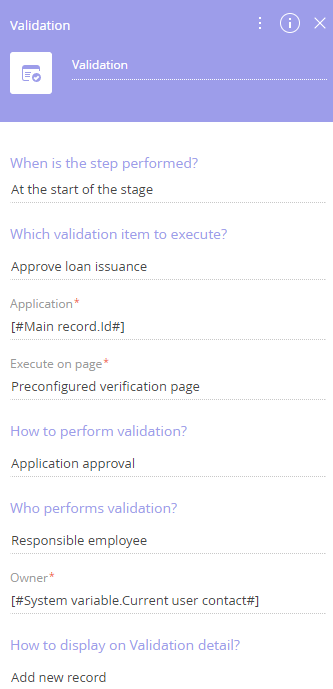[Validation item] case element (Financial Services)
The [Validation] ![]() case element is used in cases that facilitate processing of applications. This element is available only in Financial Services Creatio. Use the [Validation] element to create a validation checklist that an underwriter must complete to approve or deny a loan application. The general purpose of the [Validation] element is to automate the credit loan review.
case element is used in cases that facilitate processing of applications. This element is available only in Financial Services Creatio. Use the [Validation] element to create a validation checklist that an underwriter must complete to approve or deny a loan application. The general purpose of the [Validation] element is to automate the credit loan review.
Note
For more details on the application review automation, please see a separate article.
Specify the validation parameters in the element setup area (Fig. 1).
Fig. 1 The [Validation item] element settings

Use the parameter value window and parameter value menu to fill out the element parameters.
Specify the case element purpose by typing in a header at the top right-part of the element setup area. This will make the element more recognizable on the process diagram. Set up the element parameters.
[When is the step performed?] – indicates whether the element is activated at the start of the stage or upon completion of a specified case step.
[Which validation item to execute?] – select an item from the [Validation items] lookup. The lookup contains the list of actions that include validation questions and additional information that the employee may need during the validation process. This is a required field.
[Application] – specify the loan application to validate. Use the parameter value window to specify where the element is supposed to get the application Id. You can populate this parameter using the parameter value window. By default, it is the application that the process was run for. This is a required field.
[Execute on page] – specify the page where the validation item must be performed. By default, a pre-set Creatio validation item page is used. This is a required field.
[How to perform validation?] – select what exactly the underwriter will validate: the loan application itself or its participants. Depending on the selected method, additional parameters become available. It is a required field.
-
Select “Single participant validation” if the underwriter will be validating a specific participant. In this case, the [Participant role] field becomes available. In the field, specify the application participant whose profile should be validated. This is a required field. [Participant application form] – specify the application form of the participant. (optional).
-
Select “Multiple participant validation” if the underwriter will be validating application participants of a specific role. Select the role in the [Participant role] field.
-
Select “Application approval” if the underwriter will be validating the loan application itself.
[Who performs the task?] – select an employee or a group of employees who perform the validation. For example, the loan manager or the verification group. This is a required field.
-
Select “Group of employees” if the validation can be performed by any employee of a specific role. Select the corresponding role in the [Role of employees] field.
-
Select “Responsible employee” if the validation can be performed by a specific employee only. Select the employee in the [Owner] field.
[How to display on Validation detail?] – select a method for displaying the validation result on the [Validation] detail of the application page.
-
Select “Add new record”, Creatio will add a new record on the [Validation] detail.
-
Select “Edit existing record” to update a specific record on the [Validation] detail. In this case, you will need to specify the record to update in the [Record identifier] field.
[Validation] element advanced settings
[After Validation Saved] – in addition to the standard settings available in the advanced mode, the [Validation] element has the [After Validation Saved] field where you can specify C# code with the use of .NET Framework classes. The code will be executed after the business process creates and saves the validation item.
See also
•Getting started with dynamic cases






